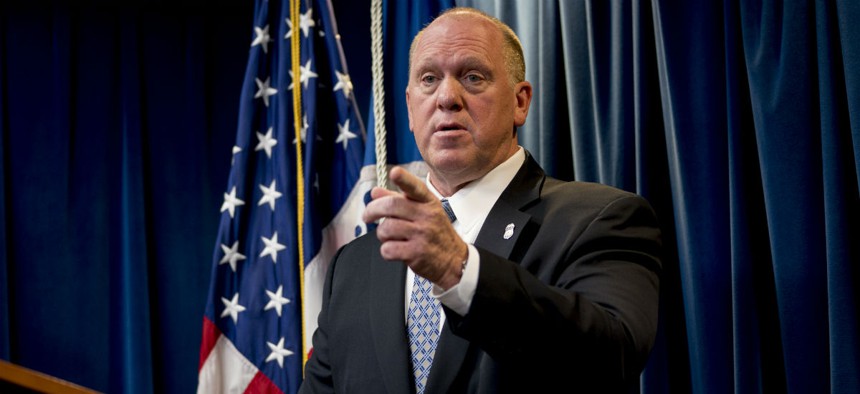New Deportation Officer Hires Dropped in Half in Trump’s First Year
ICE hired just 371 officers from more than 11,000 applications in 2017.
The Trump administration is failing to hire law enforcement personnel to enforce immigration laws despite a significant push to do so, according to new Homeland Security Department documents.
The hiring of new deportation officers at Immigration and Customs Enforcement dropped in half to just 371 total in 2017, according to information provided to potential vendors for a contract to help ICE boost hiring. The agency hired about 300 criminal investigators, an increase of more than 100 employees. ICE is currently trying to meet President Trump’s mandate that the agency hire a net of 10,000 new agents.
The figures appear in conflict with statements from acting ICE Director Thomas Homan, who said in December ICE had exceeded its 2017 hiring goals by several hundred employees. ICE did not respond to questions seeking clarification in time for publication.
DHS has emphasized new recruiting initiatives to reach the hiring quotas Trump set for both ICE and Customs and Border Protection, where the president has called on the agency to hire 5,000 new Border Patrol agents. At ICE, getting applications in the door does not appear to be a problem. The agency received 11,460 applications for deportation officer jobs last year, which means the agency hired just 3 percent of candidates despite its mandate to boost its rolls. ICE received 6,686 criminal investigator applications, for a hiring rate of 4 percent.
ICE took an average of 173 days to hire a deportation officer, so some of those applicants may still be in the pipeline. The agency decreased the average hiring time by 23 percent in 2017, another area on which DHS has focused. For criminal investigators, the average hiring time decreased by a remarkable 88 percent to just 40 days.
Just 6 percent of potential deportation officers accepted a job offer from ICE, according to the document, while 21 percent of would-be criminal investigators took the offer.
The information was submitted as an attachment to a solicitation ICE formally issued this week, seeking a private sector partner to help the agency hire 8,500 deportation officers, 1,500 criminal investigators and 6,600 support staff. ICE will pay the selected consultant a flat rate for each new employee it helps the agency hire, according to the solicitation. After initially saying the vendor would receive 80 percent of that rate when an applicant receives an official offer letter and the remaining 20 percent on the employee’s first day on the job, ICE has now created four distinct points in the hiring process for which the company can submit invoices.
The ICE consultant will manage “the full lifecycle of the hiring process,” from the job posting all the way through the testing, interview, medical examination, job offer and onboarding processes. That will include developing recruitment plans and marketing materials; deploying a recruiting staff; providing candidates with updates on their applications; conducting physical fitness, psychological and drug tests; and making an “appropriate salary determination” in compliance with the government. For law enforcement positions, the contractor will administer qualification assessments including logical reasoning, writing sample and biodata portions.
Despite ICE’s struggles to hire last year, the agency doubled its hiring request in its fiscal 2019 budget proposal to 2,000 agents. ICE proposed hiring 1,000 new agents in fiscal 2018. DHS again suggested hiring 1,000 new agents in fiscal 2019 in its initial submission to the White House, according to documents released by Sen. Claire McCaskill, D-Mo., but the administration instructed the department to double the number.
Danielle Bennett, an ICE spokeswoman, said when a request for information was released in December that ICE has received authority to use direct hiring and dual compensation waivers, and has made general improvements to its hiring processes. These changes, Bennett said, will allow ICE to "meet the anticipated unprecedented hiring numbers in the coming years."
In September, the House approved a fiscal 2018 spending bill that would provide $186.5 million for ICE to boost its ranks by 1,000 agents. A Senate appropriations bill did not provide funding for any new ICE agents. Lawmakers are currently negotiating a new appropriations package to set line-by-line spending levels across government from March 23, when the current stopgap bill is set to expire, through the end of the fiscal year. They will have much more money with which to work thanks to a budget deal Trump signed earlier this month to raise spending caps.
Despite the relative lack of new hires, ICE is fulfilling some of Trump’s promises. ICE removed more than 81,000 individuals as a result of arrests from Jan. 20 through Sept. 30, 2017, a 25 percent increase from the same period in fiscal 2016. ICE arrested 143,000 individuals for violating immigration laws in fiscal 2017, up 30 percent from the previous year. In the time since Trump took office compared to the same period in 2016, arrests jumped 42 percent.
“ICE is hitting on all cylinders,” Homan said in December.




